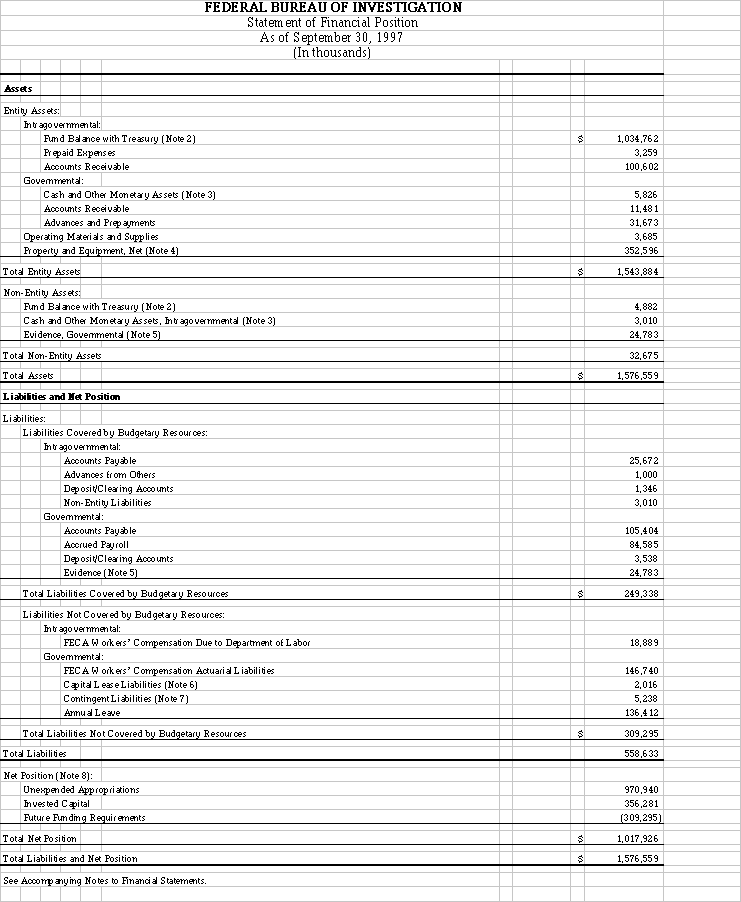
Principal Financial Statements

Notes to the Financial Statements
(1) Summary of Significant Accounting Policies
Basis of Presentation
These financial statements have been prepared to report the financial position and results of operations of the Federal Bureau of Investigation ("FBI" or "Bureau") as required by the Chief Financial Officers Act of 1990 and the Government Management Reform Act of 1994. They have been prepared from the books and records of the FBI in accordance with Office of Management and Budget (OMB) Bulletin 94-01 (and 97-01, where applicable), Form and Content of Agency Financial Statements, and the FBI's accounting policies as summarized in this note. These statements are therefore different from the financial reports, also prepared by the FBI pursuant to OMB directives, that are used to monitor and control the FBI's use of budgetary resources.
Reporting Entity
The FBI, established in 1908, is an integral part of the Department of Justice. The FBI's mission is to uphold the law and investigate violations of Federal criminal law and to protect the United States from hostile intelligence efforts. The Bureau also provides assistance to other federal, state, and local law enforcement agencies as well as to the public at large. Assistance includes forensic services, training of law enforcement officials, background investigations, name checks, fingerprint analyses, and cooperative criminal investigations.
The accompanying financial statements of the FBI include the following funds under the administrative and/or operational control of the FBI: appropriated single, multi-year, and no-year Salaries and Expense funds; appropriated Construction funds; appropriated Telecommunications Carrier Compliance fund (TCCF); and the Violent Crime Reduction Program (VCRP) trust fund.
Basis of Accounting
Transactions are recorded both on an accrual and a budgetary accounting basis. Under the accrual method, revenues are recognized when earned and expenses are recognized when a liability is incurred, without regard to receipt or payment of cash. Budgetary accounting facilitates compliance with legal constraints and controls over the use of federal funds.
Accounting Principles and Standards
The FBI applies accounting principles and standards and complies with operating policies and procedures established, issued, and implemented by the General Accounting Office (GAO), the OMB, and the Department of the Treasury, as recommended by the Federal Accounting Standards Advisory Board (FASAB). The accompanying financial statements have been prepared in accordance with the following hierarchy of accounting principles and standards, which constitutes an other comprehensive basis of accounting:
1. Statements of Federal Financial Accounting Standards effective for FY 1997;
2. Form and content requirements included in OMB Bulletins 94-01 (and 97-01, where
applicable);
3. FBI accounting policies summarized in this note;
4. Accounting principles published by authoritative standard-setting bodies and other
authoritative sources (1) in the absence of other guidance in the first three parts
of this hierarchy, and (2) if the use of such accounting standards improves the
meaningfulness of these financial statements.
Revenue and Other Financing Sources
The FBI receives funding to support its programs and execute its assigned mission(s) from two primary sources: (1) annual and multi-year appropriations by the Congress; and, (2) reimbursable activities. Appropriated funds (appropriated to the FBI or appropriated to other federal entities and transferred to the FBI for execution) represent the bulk of the FBI's operating budget. Reimbursable activities' funding comprises the balance.
Appropriations are recognized as revenues at the time the related program or administrative expenses are incurred. Appropriations expended for property and equipment are recognized as revenue concurrent with the recording of depreciation expense over the estimated useful life of the asset. Other revenues are recognized when earned, i.e., when goods have been delivered or services have been rendered.
Other revenue and financing sources consist of amounts received from the sale of FBI assets and personal property. Additionally, for FY 1997, in accordance with FASAB SFFAS #5 Accounting for Liabilities of the Federal Government, the FBI recognizes imputed financing revenue for that portion of the calculated FBI Pension and Other Retirement Benefits Expense not covered by employee and FBI contributions. This expense is paid by the Office of Personnel Management (OPM). Additionally for FY 1997, the FBI recognizes imputed financing revenue for legal claims expenses paid by the Treasury Judgment Fund on behalf of the FBI.
The FBI also receives advance payments from customers for services ordered. Until goods are delivered or services are performed, these amounts are recognized as deferred revenue, included in cash with corresponding liabilities on the Statement of Financial Position.
Fund Balance with Treasury and Cash
For the most part, the FBI does not maintain cash in commercial bank accounts. Certain receipts, however, are processed by commercial banks for deposit to individual accounts maintained at the Treasury. Cash receipts and disbursements are processed by the Treasury, and other Treasury-designated disbursing activities, as directed by authorized FBI certifying officers. Funds with the U.S. Treasury primarily represent appropriated, revolving, and trust funds available to pay current liabilities and finance future authorized purchases.
Accounts Receivable
Accounts receivable are established for amounts due for overpayments and for expenses incurred by the FBI in providing goods and services ordered. Intragovernmental receivables represent amounts due from federal entities and agencies. Governmental receivables represent amounts due from state and local governments, individuals, and other non-federal entities. The FBI does not establish allowances for uncollectible accounts receivable since, historically, amounts written off are not material.
Advances and Prepayments
Advances and prepayments classified as assets include funds disbursed to finance operations which, at September 30, 1997, exceed the total of expenditures invoiced and reported. This amount also includes advances of funds to Federal employees in advance of official travel, and the balance of travel advances in excess of travel expenses claimed on reimbursement vouchers. Payments made in advance of the FBI's receipt of goods and services are recorded as prepaid charges at the time of prepayment and recognized as expenditures/expenses when the related goods and services are received.
Operating Materials and Supplies
The general composition of operating materials and supplies is made up of ammunition, gas and oil, and office supplies. The items included in the yearend balance are located at the FBI Academy at Quantico and at the Headquarters warehouse. The FBI reports the inventory at cost using the first-in first-out method.
Property and Equipment
The FBI leases its headquarters building, field office buildings, and warehouse space from the General Services Administration (GSA). The FBI also leases office space from the Department of State and non-governmental entities, both in the Continental United States (CONUS) and abroad. The FBI also owns land and buildings.
Property and equipment are stated at cost, less accumulated depreciation. The FBI capitalizes property and equipment with an acquisition unit cost (or individual asset recognition value) greater than $25 and a useful life greater than one year. Expenditures for property and equipment with an acquisition unit cost (or individual asset recognition value) less than $25 are charged to operating expense as incurred.
Equipment with acquisition values exceeding $25 leased under agreements whose conditions meet FASAB SFFAS #6 criteria for a capital lease are recorded as fixed assets with the offsetting liability required by FASAB SFFAS #5.
Depreciation of capitalized assets is computed on a straight-line basis over the estimated useful economic lives of the assets. In the case of capital leases, the life of the asset for depreciation purposes is equal to the duration specified in the underlying lease agreement.
Evidence
In accordance with U.S. Department of Justice memorandum dated September 12, 1997, all property seized for forfeiture is to be accounted for by the Asset Forfeiture Program (AFP), including such property that also has evidentiary value. Prior to FY 1997, property seized for forfeiture was the reporting responsibility of the seizing agency.
As required by FASAB SFFAS #3, Accounting for Inventory and Related Property, monetary instruments in the custody of the FBI for evidentiary purposes are recognized as assets on the Statement of Financial Position when acquired, with an offsetting liability. Non-monetary evidence is disclosed in the footnotes at appraised or market value. Quantities of illegal drugs on hand as evidence are disclosed without value.
Liabilities
Liabilities represent the amount of monies or other resources that are likely to be paid by the FBI as the result of a transaction or event that has already occurred. However, no liability can be paid by the FBI absent proper budget authority. Liabilities for which an appropriation has not been enacted are classified as unfunded liabilities; however, there is no certainty that corresponding future appropriations will be enacted.
Contingencies
The FBI is a party in various administrative proceedings, legal actions, and claims brought by or against it. FBI management and legal counsel evaluate the probability that the FBI will be held ultimately responsible for any or all of the amounts claimed. For events where adverse actions are deemed "probable," liabilities (unfunded) are recognized. Where adverse actions are deemed only "possible," amounts are disclosed in the footnotes to the financial statements.
Annual, Sick, and Other Leave
Annual and compensatory leave is recorded as an expense with an offsetting liability as it is earned. The liability is reduced as leave is taken. Each year, the balance in the accrued annual leave liability account is adjusted to reflect valuation at current pay schedules. To the extent current or prior year appropriations are not available to fund annual and compensatory leave earned but not taken, funding will be obtained from future financing sources. Sick leave and other types of non-vested leave are expensed as used.
Retirement Plan
With few exceptions, employees hired before January 1, 1984, are covered by the Civil Service Retirement System (CSRS) and employees hired after that date are covered by the Federal Employees Retirement System (FERS).
The accompanying financial statements report expenses incurred by the FBI for required contributions made to the retirement accounts administered by the Office of Personnel Management (OPM). Additionally for FY 1997, in accordance with FASAB SFFAS #5, the FBI recognizes an additional expense and an offsetting imputed financing source for that portion of the calculated FBI Pension and Other Retirement Benefits Expense not covered by employee and FBI contributions. This expense is paid by the OPM. The FBI financial statements do not report CSRS or FERS assets, accumulated plan benefits, or unfunded liabilities, if any. Such reporting is the responsibility of the OPM.
Actuarial Liabilities
The Federal Employees' Compensation Act (FECA) provides income and medical cost protection to covered Federal civilian employees injured on the job, employees who have incurred a work-related occupational disease, and beneficiaries of employees whose death is attributable to a job-related injury or occupational disease. Claims incurred for benefits for FBI employees under FECA are administered by the Department of Labor (DOL) and are ultimately paid by the FBI.
The workers' compensation liability has two components: (1) unpaid billings; and (2) an amount of estimated unbilled claims. Unpaid billings represent claims already paid by the DOL which have not yet been passed on to the FBI. There is generally a two-year lag in the passing of DOL payments through the DOJ to the FBI. The unbilled claims are estimated by applying actuarial procedures. The DOL calculated the liability of the Federal Government for future compensation benefits, which includes the expected liability for death, disability, medical, and miscellaneous costs for approved compensation costs. The liability was determined using the paid-losses extrapolation method calculated over the next 37-year period. This method utilizes historical benefit payment patterns related to a specific incurred period to predict the ultimate payments related to that period. The projected annual benefit payments were discounted to present value. The resulting Federal Government liability was then distributed by agency. The Future Compensation Benefits Liability is recorded for reporting purposes only. This liability constitutes an extended future estimate of cost which will not be obligated against budgetary resources until the FY in which the cost is actually billed to the DOJ.
(2) Fund Balance with Treasury
Fund Balance with Treasury represents the FBI's undisbursed budgetary authority at September 30, 1997, as follows:
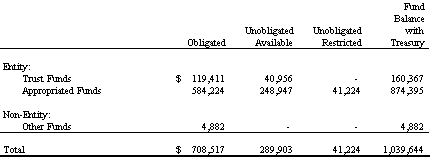
Obligated amounts consist of undelivered orders plus or minus the difference between accounts payable and accounts receivable at September 30, 1997.
Unobligated restricted amounts represent amounts remaining in expired appropriations which may not be used for new obligations-only upward adjustments to previously recorded obligations.
(3) Cash and Other Monetary Assets
Cash and Other Monetary Assets represent cash resources under the control of the FBI and may include U.S. and foreign coin and currency and negotiable instruments-some of which may be on deposit in banks and other financial institutions. At September 30, 1997, the entity asset total included $4,387 in undeposited collections and $1,439 in imprest/petty cash funds. Non-entity asset cash totaled $3,010.
(4) Property and Equipment, Net
Property and equipment and related accumulated depreciation at September 30, 1997, consisted of:
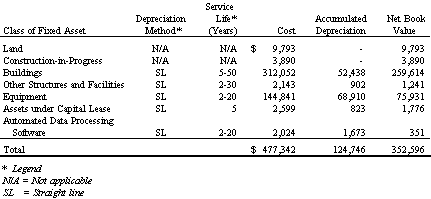
Property and equipment consists of land, structures, facilities, ADP software, machinery, vehicles, assets under capital lease, and other equipment. Straight-line depreciation is computed over the useful/economic lives of the assets (generally 2-50 years). For capital leases, the life of the asset for depreciation purposes is equal to the duration specified in the underlying lease agreement.
The Criminal Justice Information Services (CJIS) complex in Clarksburg, West Virginia was reclassified from construction-in-progress (CIP) to a fixed asset during FY 1997, as was the Tactical and Evasive Vehicle Operations Center (TEVOC) garage facility at Quantico, Virginia. Depreciation expenses for both facilities were recorded for FY 1997. Construction costs for the Tactical Firearms Training Center at Quantico are capitalized as CIP at September 30, 1997.
During FY 1997, systems furniture previously capitalized based on bulk purchases which exceeded $25 was removed from the fixed asset inventory and expensed. It was determined that the recording of bulk purchases was inconsistent with the FBI's unit cost fixed asset recognition basis. A review of the fixed asset data base disclosed that systems furniture was the only asset category for which the bulk purchase basis was used for capitalization purposes. The systems furniture removed from the fixed asset inventory had a combined acquisition cost of $10,024, accumulated depreciation of $3,696, and a net book value of $6,328. The adjustment is included in Prior Period Adjustments (see Note 9).
(5) Evidence (Unaudited)
For FY 1997, only cash, financial instruments, non-monetary property, and illegal drugs held by the FBI as evidence for legal proceedings are being reported and/or disclosed in the FBI financial statements. Property seized by the FBI for forfeiture to the DOJ Asset Forfeiture Program is reported and/or disclosed in the financial statements of the Asset Forfeiture Program.
Monetary and Non-Monetary Property
The financial values of monetary and non-monetary property in the custody of the FBI at September 30, 1997 for evidentiary purposes are presented in the following table. Only the Total Monetary amount is reported on the Statement of Financial Position, with an offsetting liability, as required by FASAB SFFAS #3. Financial instruments were recorded at face value or September 30, 1997 market value, as applicable. Non-monetary items are disclosed at appraised value or estimated market value, where appraisals could not be obtained due to chain-of-custody control purposes.
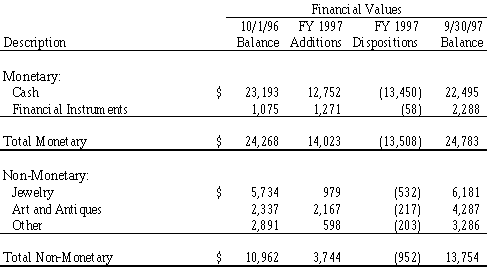
Inventory activity on evidence during FY 1997 is summarized below. Inventory data on cash is not presented since it is the same as its monetary value stated above. Information on the number of financial instruments was not available.

Non-Valued Items
The FBI also has in its custody illegal drugs as evidence for legal proceedings. The drugs are subsequently destroyed. Illegal drugs in the custody of the FBI at September 30, 1997, and the activity occurring during FY 1997, are presented in the following table. In accordance with FASAB SFFAS #3, financial values are not assigned to the drugs. (Note: Substances that were not laboratory tested and proven to be illegal drugs are not included in the information below.)

(6) Leases
Capital Leases
The acquisition value of FBI capital leases is $2,599. Leases represent copier equipment for which the acquisition value exceeds the FBI's capitalization threshold, and for which the agreement terms and conditions meet the SFFAS #6 criteria for a capital lease. The agreements are annual, renewable (but severable), lease-to-own-program (LTOP) agreements. The FBI entered into LTOP agreements solely for economic reasons, since monthly lease amounts were less than standard monthly rental amounts. The intent of the FBI, however, is not to own copier equipment.
Future Payments Due
The FBI's capital lease obligations at September 30, 1997 follow:
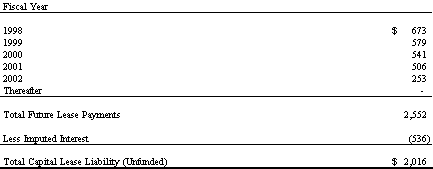
Operating Leases
The FBI has operating leases for various equipment, principally copiers, with acquisition values below the capitalization threshold. Leases are annual, renewable (but severable) agreements covering 3-5 year periods. During FY 1997, rent for equipment under operating leases was $1,753.
The FBI also has leases with both commercial and government entities for various office, parking, and radio tower facilities. Contract agreements for commercial leases provide the FBI annual options to terminate the leases without termination or liquidating damage charges. However, the FBI anticipates continuing these operating leases in future years. The majority of leased office space is from the General Services Administration (GSA). Rent charged by GSA is based on square footage leased by the FBI at approximate commercial rates. During FY 1997, lease expenses for office, parking, and radio tower facilities was $211,674. The FBI does not expect operating lease expenses to increase substantially in future periods.
(7) Contingencies
The FBI is a defendant in various administrative proceedings, legal actions, and claims. The statement of financial position recognizes $5,238 in unfunded liabilities for those events where adverse actions are considered "probable" by the FBI's Office of General Counsel (OGC). The amount recognized includes $452 for civil litigation claims, $900 for federal tort claims, $3,500 for a Privacy Act case, and $386 for employment litigation claims. Settlements greater than $2.5 in tort cases are eligible for payment out of the Treasury Judgment Fund. During FY 1997, the Treasury Judgment Fund paid $4,241 in FBI-expensed claims.
The following discloses the number and potential amount of contingencies for events where, in the opinion of the OGC, the likelihood of adverse actions are considered more than "remote," but less than "probable." The OGC used a $1 million threshold for disclosure of Bivens and Tort Claims contingencies. The disclosure of Employment contingencies was without regard to threshold.

The Office of General Counsel has no specific knowledge of any significant unasserted claims and/or assessments against the FBI.
(8) Net Position
The net position of the FBI as of September 30, 1997, was made up of the following components:

Invested capital represents the total of the "Operating Materials and Supplies" and "Property and Equipment, Net" entity asset categories.
Future funding requirements represent those liabilities not covered by budgetary resources.
(9) Prior Period Adjustments
The following categories summarize prior period adjustments:
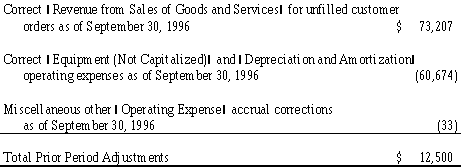
(10) Nonoperating Changes
Changes in net position, other than excess of revenues over total expenses, as of September 30, 1997 were as follows:
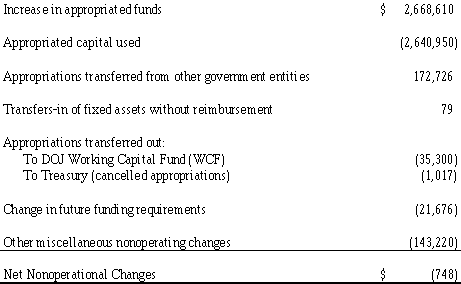
#####